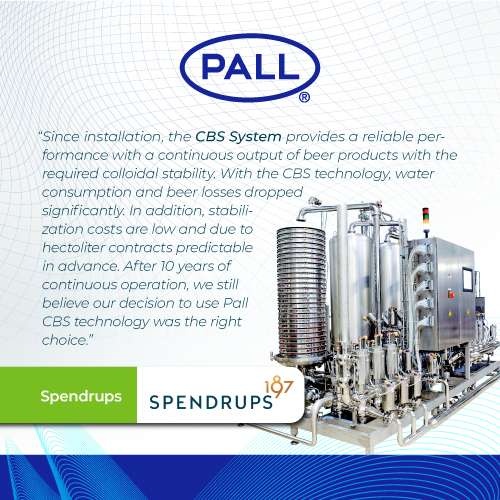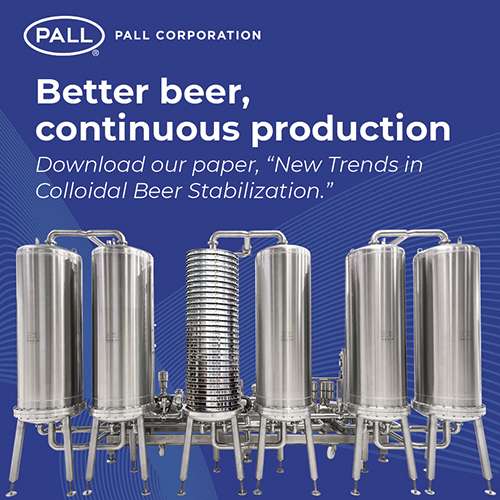Subscribe to our blog to stay up-to-date on the latest food and beverage insights and trends

How to Sustainably Achieve and Protect Beer Clarity
Sep, 2025
Sustainable Beer Clarification: Reducing Haze Formation
Removing turbidity after fermentation and maturation is the first step in achieving beer clarity and stability. After clarification, the next critical steps are colloidal and microbial stabilization which are processes that ensure beer maintains its brilliant clarity and shelf stability. These finishing touches are what give filtered beer its polished, market-ready appearance and widespread appeal.
Learn more about beer filtration fundamentals and clarity techniques
Why Polyphenols Cause Beer Haze
This initial clarity, however, may not last. Clarified beers must display stability with respect to haze, meaning that the beer must stay bright during the period from dispatch from the brewery to consumption.
Beer haze and its chemistry is a complicated matter. A wide range of substances can cause non-biological haze formation (colloidal haze). The most important type of non-biological haze is caused by reaction of proteins and polyphenols which are brought into the brewing process by the raw materials, including hops.
Shelf-life factors including transport, agitation, temperature shifts, and sunlight exposure, can negatively affect clarity and flavor stability. This is especially relevant in low and no alcohol beer production, where the absence of alcohol can amplify sensitivity to haze and microbial instability. As demand for these formats grows, maintaining clarity and shelf-life becomes even more critical.
The Biggest Threat to Persistent Clarity – Beer Haze
Colloidal haze is formed during cold fermentation and maturation and is usually removed during clarification/filtration, however the reactions between proteins and polyphenols can continue after filtration if enough remain.
Polyphenols are categorized by their tanning capacity—their ability to form complexes with proteins. Proanthocyanidins are the most significant tanning polyphenols, with reactivity increasing through polymerization and oxidation. To prevent permanent haze, modern stabilization methods aim to remove at least one reaction partner.
While there are different technologies to remove haze active proteins, including adsorption, precipitation and dosage of enzymes, there is only one major technology that reduces the haze active polyphenols: the usage of Polyvinylpolypyrrolidone – PVPP.
PVPP: A Proven Solution for Beer Stabilization
PVPP is a cross-linked polymer of PVP, a substance which is widely used in medicine, for example. By crosslinking, the molecule becomes insoluble so that PVPP can be completely removed after it has fulfilled its technological task.
PVPP has a large surface area onto which haze-forming polyphenols are bound by strong hydrogen bonding. The PVPP particles adsorb the polyphenols in the beer and remove them.
PVPP can be used as a single-use material or regenerated. In regenerable systems, PVPP is retained and cleaned with caustic after adsorption.
This approach is equally effective in low and no alcohol beer production, where clarity and flavor retention are essential to consumer acceptance. These formats often require more precise stabilization due to their heightened sensitivity to haze formation. Discover Pall’s low and no alcohol beer filtration solutions.
Optimizing PVPP with Pall’s CBS System
1. Reduction of lost microparticles
PVPP particles are classified as microparticles, and their release is increasingly scrutinized. In classic regeneration cycles, 0.3–1% of PVPP is typically lost, amounting to several kilograms per cycle.
While conventional systems rely on trap filters, Pall’s fixed-bed CBS technology reduces PVPP loss to non-detectable levels - less than 0.3% over 1,000 cycles. When PVPP is exhausted, it’s professionally recovered and disposed of, preventing environmental release.
2. Advantageous technology and ease of use
CBS systems can reduce total polyphenols by ~50% and anthocyanogens by ~70%, achieving more than 10 warm days (0/60). Stabilization intensity depends on raw materials and SKU type. CBS allows precise control via column interaction and bypass regulation, with programmable recipes for different production needs.
Its compact design also reduces CIP costs and beer losses compared to traditional PVPP systems or alternative stabilization methods.
Key benefits of the CBS system include:
- Reduction of total polyphenols by up to 50%
- Reduction of anthocyanogens by up to 70%
- Achieves more than 10 warm days (0/60)
- Programmable stabilization recipes for different SKUs
- Precise control via column interaction and bypass regulation
- Lower beer losses and CIP costs due to compact vessel design
- Minimal PVPP particle loss—less than 0.3% over 1,000 cycles
- Environmentally responsible PVPP recovery and disposal
These benefits are especially valuable for non-alcoholic beer producers, who face tighter margins and greater sensitivity to product loss and instability.
Learn more about sterile filtration for beer as a sustainable alternative to pasteurization.
Conclusion to Sustainable Beer Clarity
To maintain clarity in filtered beer, it’s essential to address haze formation primarily caused by protein–polyphenol reactions. Reducing these reaction partners is key.
PVPP is globally recognized as one of the most effective stabilization methods. Pall’s CBS system enhances this approach with sustainable, cost-effective technology that simplifies operations and minimizes microparticle loss.
These benefits extend across all beer formats including low and no alcohol beers where clarity, stability, and sustainability are increasingly vital to meet consumer expectations and production demands.
- Category
- Author
- Sort By





